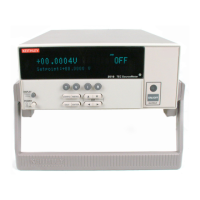6-14 Remote Operations Models 2510 and 2510-AT User’s Manual
<numlist> Numlist — Specify one or more numbers for a list. Example:
:STATus:QUEue:ENABle (-110:-222) Enable errors -110
through -222
<NDN> Non-decimal numeric — This parameter is used to send values in the binary,
octal, or hexadecimal format. The prefix designates the format type:
#Bxx...x #B specifies the binary format.
xx...x is the binary number (using 0s and 1s).
#Qxx...x #Q specifies the octal format.
xx...x is the octal number (values 0 through 7).
#Hxx...x #H specifies the hexadecimal format.
xx...x is the hexadecimal number (values 0 through 9 and
A through F).
Examples to send the decimal value 36 in the non-decimal formats:
*ESE #b100100 Binary format
*ESE #q44 Octal format
*ESE #h24 Hexadecimal format
Angle brackets < > — Angle brackets (< >) are used to denote a parameter type. Do not
include the brackets in the program message.
Query commands
This type of command requests (queries) the presently programmed status. It is identified
by the question mark (?) at the end of the fundamental form of the command. Most com-
mands have a query form:
:SOURce:VOLTage? Queries the output voltage.
Case sensitivity
Common commands and SCPI commands are not case sensitive. You can use upper or
lower case and any case combination. Examples:
*RST = *rst
:SYSTem:PRESet = :system:preset
NOTE Using all upper case will result in slightly faster command response times.

